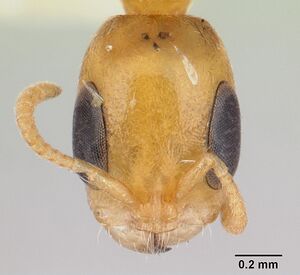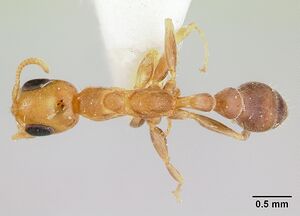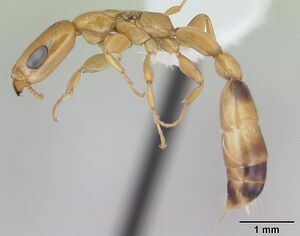Pseudomyrmex filiformis
| Pseudomyrmex filiformis | |
|---|---|

| |
| Scientific classification | |
| Kingdom: | Animalia |
| Phylum: | Arthropoda |
| Class: | Insecta |
| Order: | Hymenoptera |
| Family: | Formicidae |
| Subfamily: | Pseudomyrmecinae |
| Genus: | Pseudomyrmex |
| Species: | P. filiformis |
| Binomial name | |
| Pseudomyrmex filiformis (Fabricius, 1804) | |
| Synonyms | |
| |
Ward (1996) suggests this ant is a temporary social parasite of a number of common, co-occurring Pseudomyrmex species, including Pseudomyrmex elongatus, Pseudomyrmex holmgreni and Pseudomyrmex (sp. PSW-14).
| At a Glance | • Temporary parasite |
Identification
Keys including this Species
Distribution
Latitudinal Distribution Pattern
Latitudinal Range: 19.58333° to -22.809943°.
| North Temperate |
North Subtropical |
Tropical | South Subtropical |
South Temperate |
- Source: AntMaps
Distribution based on Regional Taxon Lists
Neotropical Region: Argentina, Brazil, Colombia, Costa Rica, Ecuador, French Guiana, Guatemala, Guyana, Mexico, Panama, Paraguay, Peru, Suriname, Trinidad and Tobago, Venezuela.
Distribution based on AntMaps
Distribution based on AntWeb specimens
Check data from AntWeb
Countries Occupied
| Number of countries occupied by this species based on AntWiki Regional Taxon Lists. In general, fewer countries occupied indicates a narrower range, while more countries indicates a more widespread species. |

|
Estimated Abundance
| Relative abundance based on number of AntMaps records per species (this species within the purple bar). Fewer records (to the left) indicates a less abundant/encountered species while more records (to the right) indicates more abundant/encountered species. |

|
Biology
Ward (1996) - Incipient colonies of this species have been found inhabiting a nest in small dead twigs with several workers of a different Pseudomyrmex species. This contrasts with mature colonies, which form large monospecific nests with a single functional queen. This suggests the queens are temporary social parasites.
Gillette et al. (2015) in a Chaipas, Mexico field study of twig-nesting ants in coffee plants found P. ejectus occurred in 9% of the twigs with nests. All of its nests were below 1300 m.
Castes
Worker
Images from AntWeb
   
| |
| Worker. Specimen code casent0178622. Photographer April Nobile, uploaded by California Academy of Sciences. | Owned by MIZA, Maracay, Venezuela. |
   
| |
| Specimen code lacm. . | |
Queen
Images from AntWeb
   
| |
| Queen (alate/dealate). Specimen code casent0173753. Photographer April Nobile, uploaded by California Academy of Sciences. | Owned by ALWC, Alex L. Wild Collection. |
Nomenclature
The following information is derived from Barry Bolton's Online Catalogue of the Ants of the World.
- filiformis. Formica filiformis Fabricius, 1804: 405 (q.) CENTRAL AMERICA. Wheeler, W.M. 1919i: 125 (w.m.); Wheeler, G.C. & Wheeler, J. 1956: 384 (l.). Combination in Leptalea: Erichson, 1839: 309; in Pseudomyrma: Roger, 1862c: 289; in Pseudomyrmex: Wheeler, G.C. & Wheeler, J. 1956: 384. Senior synonym of cephalica: Roger, 1862c: 289; of biconvexa: Wheeler, W.M. 1919i: 125; of longiceps Forel, longiceps Stitz: Ward, 1989: 438.
- cephalica. Pseudomyrma cephalica Smith, F. 1855c: 168 (w.q.m.) BRAZIL. Junior synonym of filiformis: Roger, 1862c: 289.
- biconvexa. Pseudomyrma biconvexa Forel, 1899c: 95, pl. 4, fig. 10 (w.) GUATEMALA. Junior synonym of filiformis: Wheeler, W.M. 1919i: 125.
- longiceps. Pseudomyrma biconvexa var. longiceps Forel, 1906d: 229 (w.) COLOMBIA. Combination in Pseudomyrmex: Kempf, 1972a: 218. Subspecies of filiformis: Wheeler, W.M. 1919i: 131. Junior synonym of filiformis: Ward, 1989: 438.
- longiceps. Pseudomyrma longiceps Stitz, 1933: 68 (q.) VENEZUELA. [Unresolved junior primary homonym of longiceps Wheeler, above.] Combination in Pseudomyrmex: Kempf, 1972a: 221. Junior synonym of filiformis: Ward, 1989: 438.
Description
Type Material
Ward (1989):
Syntype dealate queen, Essequibo, Guyana (Smidt) (Zoologisk Museum, University of Copenhagen) [Examined]; here designated as LECTOTYPE. A second syntype dealate queen in ZMUC, lacking head, metasoma, and a locality label, has been labelled paralectotype.
Pseudomyrma cephalica F. Smith, 1855:168. Dealate queen, labelled as type, Santarem, Brazil (Bates); two workers. probable syntypes, Villa Nova, Brazil (Bates) (The Natural History Museum) [Examined].
Pseudomyrma biconvexa Forel, 1899:95. Syntype workers, Pantaleon, Guatemala (Champion) (BMNH, Musee d'Histoire Naturelle Genève); Costa Rica (Tonduz) (BMNH) [Examined].
Pseudamyrma biconvexa var. longiceps Forel, 1906:229. Syntype worker, Santa Marta, Colombia (A. Forel) (MHNG) [Examined].
Pseudomyrma longiceps Stitz, 1933:69. Holotype queen, Macuto, near La Guayra, Venezuela (e. Gazgo) (not in Zoologisches Institut und Zoologisches Museum der Universität Hamburg. probably destroyed during World War II).
The syntype worker of P. longiceps (Forel) is simply a large P. filiformis worker, with a rather elongate head and a conspicuous subpetiolar tooth. I have seen such variant workers within nest-series of typical P. filiformis from elsewhere in Central and South America. Although the unique type of P. longiceps (Stitz) is lost, the original description (particularly as it pertains to head length, position of eyes, and petiole shape) is closer to that of P. filiformis than any other species known to me.
References
- Erichson, W. F. 1839. Bericht über die Leistungen im Gebiete der Naturgeschichte während des Jahres 1838. IX. Insecten. Arch. Naturgesch. 5(2 2: 281-375 (page 309, Combination in leptalea)
- Fabricius, J. C. 1804. Systema Piezatorum secundum ordines, genera, species, adjectis synonymis, locis, observationibus, descriptionibus. Brunswick: C. Reichard, xiv + 15-439 + 30 pp. (page 405, queen described)
- Franco, W., Ladino, N., Delabie, J.H.C., Dejean, A., Orivel, J., Fichaux, M., Groc, S., Leponce, M., Feitosa, R.M. 2019. First checklist of the ants (Hymenoptera: Formicidae) of French Guiana. Zootaxa 4674, 509–543 (doi:10.11646/zootaxa.4674.5.2).
- Gillette, P. N., K. K. Ennis, G. D. Martinez, and S. M. Philpott. 2015. Changes in Species Richness, Abundance, and Composition of Arboreal Twig-nesting Ants Along an Elevational Gradient in Coffee Landscapes. Biotropica. 47:712-722. doi:10.1111/btp.12263
- Roger, J. 1862c. Synonymische Bemerkungen. 1. Ueber Formiciden. Berl. Entomol. Z. 6: 283-297 (page 289, Combination in Pseudomyrma, Senior synonym of cephalica)
- Ward, P. S. 1989a. Systematic studies on pseudomyrmecine ants: revision of the Pseudomyrmex oculatus and P. subtilissimus species groups, with taxonomic comments on other species. Quaest. Entomol. 25: 393-468 (page 438, Senior synonym of longiceps Forel and longiceps Stitz)
- Ward, P. S. 1996. A new workerless social parasite in the ant genus Pseudomyrmex (Hymenoptera: Formicidae), with a discussion of the origin of social parasitism in ants. Systeamtic Entomology. 21:253-263.
- Wheeler, G. C.; Wheeler, J. 1956. The ant larvae of the subfamily Pseudomyrmecinae (Hymenoptera: Formicidae). Ann. Entomol. Soc. Am. 49: 374-398 (page 384, larva described, Combination in Pseudomyrmex)
- Wheeler, W. M. 1919k. A singular neotropical ant (Pseudomyrma filiformis Fabricius). Psyche (Camb.) 26: 124-131 (page 125, worker, male described, Senior synonym of biconvexa)
References based on Global Ant Biodiversity Informatics
- Crawley W. C. 1916. Ants from British Guiana. Ann. Mag. Nat. Hist. 8(17): 366-378.
- Dattilo W. et al. 2019. MEXICO ANTS: incidence and abundance along the Nearctic-Neotropical interface. Ecology https://doi.org/10.1002/ecy.2944
- Davidson, D.W. 2005. Ecological stoichiometry of ants in a New World rain forest. Oecologia 142:221-231
- De la Mora, A., C. J. Murnen, and S. M. Philpott. 2013. Local and landscape drivers of biodiversity of four groups of ants in Neotropical coffee landscapes. Biodiversity and Conservation 22: 871-888.
- Favretto M. A., E. Bortolon dos Santos, and C. J. Geuster. 2013. Entomofauna from West of Santa Catarina State, South of Brazil. EntomoBrasilis 6 (1): 42-63.
- Fernández F., E. E. Palacio, W. P. Mackay, and E. S. MacKay. 1996. Introducción al estudio de las hormigas (Hymenoptera: Formicidae) de Colombia. Pp. 349-412 in: Andrade M. G., G. Amat García, and F. Fernández. (eds.) 1996. Insectos de Colombia. Estudios escogidos. Bogotá: Academia Colombiana de Ciencias Exactas, Físicas y Naturales, 541 pp
- Fernández, F. and S. Sendoya. 2004. Lista de las hormigas neotropicales. Biota Colombiana Volume 5, Number 1.
- Forel A. 1905. Miscellanea myrmécologiques II (1905). Ann. Soc. Entomol. Belg. 49: 155-185.
- Forel A. 1906. Fourmis néotropiques nouvelles ou peu connues. Annales de la Société Entomologique de Belgique 50: 225-249.
- Forel A. 1912. Formicides néotropiques. Part IV. 3me sous-famille Myrmicinae Lep. (suite). Mémoires de la Société Entomologique de Belgique. 20: 1-32.
- Franco W., N. Ladino, J. H. C. Delabie, A. Dejean, J. Orivel, M. Fichaux, S. Groc, M. Leponce, and R. M. Feitosa. 2019. First checklist of the ants (Hymenoptera: Formicidae) of French Guiana. Zootaxa 4674(5): 509-543.
- INBio Collection (via Gbif)
- Kempf W. W. 1978. A preliminary zoogeographical analysis of a regional ant fauna in Latin America. 114. Studia Entomologica 20: 43-62.
- Kempf, W.W. 1972. Catalago abreviado das formigas da regiao Neotropical (Hym. Formicidae) Studia Entomologica 15(1-4).
- Longino J. et al. ADMAC project. Accessed on March 24th 2017 at https://sites.google.com/site/admacsite/
- Maes, J.-M. and W.P. MacKay. 1993. Catalogo de las hormigas (Hymenoptera: Formicidae) de Nicaragua. Revista Nicaraguense de Entomologia 23.
- Pires de Prado L., R. M. Feitosa, S. Pinzon Triana, J. A. Munoz Gutierrez, G. X. Rousseau, R. Alves Silva, G. M. Siqueira, C. L. Caldas dos Santos, F. Veras Silva, T. Sanches Ranzani da Silva, A. Casadei-Ferreira, R. Rosa da Silva, and J. Andrade-Silva. 2019. An overview of the ant fauna (Hymenoptera: Formicidae) of the state of Maranhao, Brazil. Pap. Avulsos Zool. 59: e20195938.
- Ribas C. R., J. H. Schoereder, M. Pic, and S. M. Soares. 2003. Tree heterogeneity, resource availability, and larger scale processes regulating arboreal ant species richness. Austral Ecology 28(3): 305-314.
- Rico-Gray,V., J.G. Garcia-Franco, M. Palacios-Rios, C. Diaz-Castelazo, V. Parra-Tabla and J.A. Navarro. 1998. Geographical and Seasonal Variation in the Richness of Ant-Plant Interactions in Mexico. Biotropica 30(2):190-200.
- Rojas Fernandez P. 2010. Capítulo 24. Hormigas (Insecta: Hymenoptera: Formicidae). In: Diversidad Biológica de Veracruz. Volumen Invertebrados. CONABIO-Gobierno del Estado de Veracruz.
- Rosa da Silva R. 1999. Formigas (Hymenoptera: Formicidae) do oeste de Santa Catarina: historico das coletas e lista atualizada das especies do Estado de Santa Catarina. Biotemas 12(2): 75-100.
- Schoereder J. H., T. G. Sobrinho, M. S. Madureira, C. R. Ribas, and P. S. Oliveira. 2010. The arboreal ant community visiting extrafloral nectaries in the Neotropical cerrado savanna. Terrestrial Arthropod Reviews 3: 3-27.
- Silvestre R., C. R. F. Brandão, and R. R. Silva da 2003. Grupos funcionales de hormigas: el caso de los gremios del cerrado. Pp. 113-148 in: Fernández, F. (ed.) 2003. Introducción a las hormigas de la región Neotropical. Bogotá: Instituto de Investigación de Recursos Biológicos Alexander von Humboldt, xxvi + 424 pp.
- Stitz H. 1933. Neue Ameisen des Hamburger Museums (Hym. Form.). Mitt. Dtsch. Entomol. Ges. 4: 67-75.
- Ulyssea M.A., C. E. Cereto, F. B. Rosumek, R. R. Silva, and B. C. Lopes. 2011. Updated list of ant species (Hymenoptera, Formicidae) recorded in Santa Catarina State, southern Brazil, with a discussion of research advances and priorities. Revista Brasileira de Entomologia 55(4): 603-611.
- Vasconcelos H. L., J. M. S. Vilhena, W. E. Magnusson, and A. L. K. M. Albernaz. 2006. Long-term effects of forest fragmentation on Amazonian ant communities. Journal of Biogeography 33: 1348-1356.
- Vasconcelos, H.L., J.M.S. Vilhena, W.E. Magnusson and A.L.K.M. Albernaz. 2006. Long-term effects of forest fragmentation on Amazonian ant communities. Journal of Biogeography 33:1348-1356
- Vásquez-Bolaños M. 2011. Lista de especies de hormigas (Hymenoptera: Formicidae) para México. Dugesiana 18: 95-133
- Ward P. S. 1990. The Ant Subfamily Pseudomyrmecinae (Hymenoptera: Formicidae): Generic Revision and Relationship to Other Formicids. Systematic Entomology 15: 449-489
- Ward P. S. 1992. Ants of the genus Pseudomyrmex (Hymenoptera: Formicidae) from Dominican amber, with a synopsis of the extant Antillean species. Psyche (Cambridge) 99: 55-85
- Ward P. S., and D. A. Downie. 2005. The ant subfamily Pseudomyrmecinae: phylogeny and evolution of big-eyed arboreal ants. Systematic Entomology 30: 310-335.
- Ward, P. S. 1989. Systematic Studies on Pseudomyrmecine Ants: Revision of the Pseudomyrmex Oculatus and P. Subtilissimus Species Groups with Taxonomic Comments on Other Species. Questiones Entomologicae 25: 393-468
- Wheeler W. M. 1919. A singular neotropical ant (Pseudomyrma filiformis Fabricius). Psyche (Cambridge) 26: 124-131.
- Wheeler W. M. 1922. The ants of Trinidad. American Museum Novitates 45: 1-16.
- Wild, A. L. "A catalogue of the ants of Paraguay (Hymenoptera: Formicidae)." Zootaxa 1622 (2007): 1-55.
- de Almeida Soares S., Y. R. Suarez, W. D. Fernandes, P. M. Soares Tenorio, J. H. C. Delabie, and W. F. Antonialli-Junior. 2013. Temporal variation in the composition of ant assemblages (Hymenoptera, Formicidae) on trees in the Pantanal floodplain, Mato Grosso do Sul, Brazil. Rev. Bras. entomol. 57: 84-90
- Pages using DynamicPageList3 parser function
- Ant Associate
- Host of Pseudomyrmex elongatus
- Host of Pseudomyrmex holmgreni
- Host of Pseudomyrmex (sp. PSW-14)
- Temporary parasite
- Tropical
- Species
- Extant species
- Formicidae
- Pseudomyrmecinae
- Pseudomyrmex
- Pseudomyrmex filiformis
- Pseudomyrmecinae species
- Pseudomyrmex species
- Need Body Text

